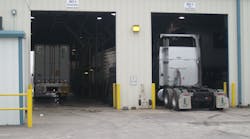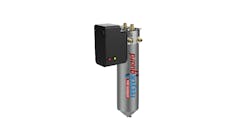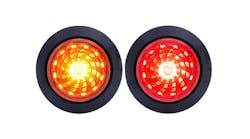When it comes to establishing and following a systematic maintenance program, it is all too easy to forget about the trailers. The problem with that is other people – the Federal Motor Carrier Safety Administration, officers on the road and plaintiffs’ attorneys – have reasons to become concerned about the effectiveness of your trailer maintenance program.
Basically, you need to treat the trailers the same as you do power units. The only real difference is that trailers have fewer components, which makes the process a little easier.
START WITH THE OEM
To begin the process, contact the original equipment manufacturer (OEM) and ask for the recommended service items and service intervals for the trailer. If the trailer has an auxiliary engine of some type – such as on a refrigerated trailer or a detachable lowboy trailer, you will need to remember to get information specific to the engine and attached system.
The information provided by the OEM provides your “baseline” when it comes to establishing maintenance schedules – both the interval and the items to be checked. This baseline needs to be adjusted based on your use of the trailer (i.e., whether it is more severe than the manufacturer’s expectations), your maintenance history with similar equipment and other factors unique to your operation.
CREATE CHECKLISTS
Part of this process will need to be creating a checklist of items that are to be inspected, adjusted or replaced. This checklist will provide guidance to the technician that is doing the inspection and service. It provides documentation that proves the vehicle was maintained.
The checklist, if structured correctly, documents the condition of the vehicle at the time of the service – before and after. This could prove critical if the trailer is involved in some type of incident and maintenance is a concern.
When constructing the checklist, remember to include detailed instructions. An example would be to provide the torque requirements to be used when checking the lug nuts. By providing such details, it clarifies how the activity is to be completed.
Also, you should provide a spot for the technician to record any measurements taken, such as brake slack adjuster free play, brake lining thickness and tire tread depth.
KEEP TRACK
Once the schedule and checklist have been established, you will need to come up with a tracking mechanism to make sure the trailers are being routed in for the scheduled maintenance. If you have the ability to track mileage on your trailers and have visibility on the mileage, then simply following the mileage standard would be the easiest and most effective thing to do.
This is because mileage, in the case of power units or trailers, is what wears components. As an example, brakes and tires will wear faster on a trailer that is putting miles on daily versus one that is parked for periods of time.
This can be difficult in many operations due to the usage of trailers not being tracked as closely as the usage of power units. One solution that some carriers have arrived at is using an “average mileage” to calculate out the date a service should be due.
For example, if you have decided that you want to conduct scheduled maintenance every 20,000 miles on your trailers, you would need to calculate how long it takes an average trailer in your fleet to accumulate 20,000 miles. If the average is three months, then the trailer service schedule would need to be set at three months.
A variation on this is calculating the soonest a trailer would be able to arrive at the target mileage, and then use this as the interval. An example would be that you have determined that the average time it takes to make the target miles is three months, but a significant number of the trailers are doing the miles in only two months. In this case, it might be wise to use two months, rather than three.
Finally, at specific points, more in-depth service activities should be scheduled as well. An example would be deciding to verify trailer alignment annually or during every fourth inspection – if you are doing them every 90 days, or at an inspection that is tied to a specific mileage.
REQUIREMENTS
When determining the maintenance schedule, be sure to factor in any inspections that are required by outside entities and regulatory bodies. These include the annual inspection required under the state or federal regulations, the 90-day inspection required for any trailer based in California, tank trailer inspections required under the state or federal hazardous materials regulations and any customer-required inspections.
The key here is to try to coordinate the maintenance schedule to avoid duplication of effort, say doing a scheduled service just a few weeks after doing a required inspection.
MEAN TIME BETWEEN FAILURES
One practice that is used on power unit components should be carried over to trailers as well, and that is using data to try to predict when a failure will occur. The information can then be used to develop a maintenance strategy that will allow such issues to be addressed in advance.
This means collecting data whenever there is a part or component failure. This data can then be aggregated and mined.
An example would be seeing in the data that there is a high frequency of bearing failures, discovered either on the road or during maintenance. Also, the data indicates there is a certain time or mileage range during which the trailer bearings are failing.
This information can then be used to modify the maintenance scheduling. At a specified time or mileage, the bearings are to undergo a detailed inspection – such as at each quarterly inspection – or be replaced, regardless of condition.
While not ideal, this can be effective at preventing on-road failures. It is not ideal because you may end up replacing components that still have some useful life, thereby increasing your maintenance costs in the long run. However, if the failures are frequent enough, and costly enough when they occur, this can justify the extra costs.
CUT-OFF LIMITS
Another part of your service needs to be comparing components to specific “wear limits,” and replacing them when they reach the limit. A starting point for some common components are the limits provided in the regulations. These include, as examples, 2/32” tread depth on trailer tires, 1/4” thickness on brake linings – when viewed from the side – and brake drums not worn below the manufacturer’s declared minimums.
While these numbers are directly from the regulations, they need to be adjusted. The reason for this is if you release a trailer from a maintenance inspection with tires that are at 3/32”, and you are not going to see it for three months, the odds are good that the tires will fall below the minimum before you see it again. You will need to establish an internal cut-off limit that is higher than the regulations require, such as 4/32” tread depth.
The same principle applies to all of the items that wear on the trailer and have a regulatory limit. The internal cut-off limits will need to be set at a point where normal wear will not put them below the regulatory limit before the trailer will be back for its next scheduled maintenance.
When establishing these internal cut-off limits, you need to consider your operating environment. If your trailers will be regularly operating in snow, you might want to consider a different tire tread depth cut-off limit than a fleet that operates primarily in the southwestern United States.
If your equipment operates regularly in mountainous or hilly terrain, you may want to replace brake linings sooner than if the fleet was operated primarily in the Midwest.
During inspections and maintenance, the exact measurements should be included on the inspection and maintenance checklist. If any component is replaced, that should be documented as well. As mentioned earlier, this shows that you have a systematic and effective trailer maintenance program and it documents the condition of the trailer.
PRINCIPAL MEASURES
The key to the entire process is that it must be systematic and effective. While you might claim that you have a “system” by stating that “We fix it when it’s broken,” the process is not effective.
The measures used during an audit to determine if a maintenance program is effective include:
- Verifying that the trailers are being serviced as outlined in your maintenance schedule.
- Your maintenance schedule is reasonable for your operation.
- Your trailers are passing any roadside inspections they undergo.
- Major problems are not being found by technicians during maintenance or by drivers on the road, and when problems are found they are immediately repaired.
- There is documentation proving all of the above.
Be sure to include these measures in your trailer maintenance program so you pass the test for the program being both systematic and effective.
Tom Bray is the leader editor for transport management at J. J. Keller & Associates (www.jjkeller.com), a leader in safety and regulatory compliance. With subject-matter expertise spanning a multitude of industries and regulatory agencies, the company offers consulting and managed services for fleet and transportation, workplace safety and environmental issues and human resources. It also offers electronic logging devices, training, online management tools, publications and forms and supplies.



